 |
Picks is a monthly sampling of Japan's art scene, offering commentary by a variety of reviewers about exhibitions at museums and galleries in recent weeks, with an emphasis on contemporary art by young artists. |
 |
 |
|
|
 |
|
| Ikeda Tatsuo: An Elliptical Visionary -- The Present Tense of Postwar Art |
| 26 April - 17 June 2018 |
Nerima Art Museum
(Tokyo) |
 |
| The subject of this retrospective is a painter who turns 90 this year on 15 August, the 73rd anniversary of Japan’s surrender ending World War II. All six “chapters” of the show address the theme of war in Ikeda’s work. Chapter 0 is the most impressive, followed by subsequent sections of decreasing interest. The problem lies in the war’s indelible impact on the artist in his youth. Trained as a kamikaze suicide pilot, he was never able to develop other themes that transcended that seminal experience. Though he dabbled in different styles and techniques, his work only seems to have grown weaker, its maturity inversely proportional to his years. |
|
|
 |
 |
|
| Taku Satoh: MASS |
| 30 April - 12 May 2018 |
Gallery Kobo
(Tokyo) |
 |
| Graphic designer Satoh has developed the packages and brand logos of countless mass-produced goods. His fascination with how these products came to be designed as they are was the spark for his “Design Anatomy” project, launched in 2001. An extension of that project, the current show featured larger-than-life toothpaste tube heads oozing blobs of a viscous substance. Though we enjoy the benefits of many such products in our daily lives, we rarely feel grateful for them and tend to focus on the negative consequences of mass production, such as environmental pollution. Satoh displays a shrewd sensitivity to such biases. |
|
|

|
 |
 |
|
 |
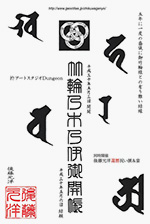 |
 |
| Motohiro Goto: Unveiling of the Sacred Chikuwa Mummy |
| 3 - 6 May 2018 |
Art Studio Dungeon
(Tokyo) |
 |
| The legendary Chikuwa has returned. In this veritably dungeon-like subterranean exhibit space, performer/photographer Goto displayed several series of photos of his exploits since the 1980s. His recent color works feature nude bathing and other of his trademark physical performances. In another chamber, viewable via remote camera, sits the mummified deity Chikuwa, a desiccated tube of fish cake unveiled to the public only once every five years. The ultra-nonsensical object of worship makes swift work of such conceptual frameworks as contemporary art, performance, and installation, demolishing them in a thoroughly satisfying manner. |
|
|
|
|
|
|
|

|
 |
 |
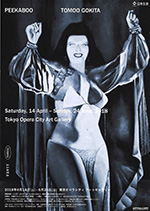 |
 |
| Tomoo Gokita: PEEKABOO |
| 14 April - 24 June 2018 |
Tokyo Opera City Art Gallery
(Tokyo) |
 |
| The works here could arguably be called photographic art. Granted, Gokita’s materials are acrylic paint and canvas, but the paintings replicate photos found in countercultural or underground publications from the America of the sixties and seventies. Their photographic origins are accented by the artist’s use of monochrome light-dark gradations and a reproduction-like attention to detail. By skillfully regulating the degree of photorealism, Gokita is able to conjure up an intimate mood in his images. |
|
|
 |
 |
| Seiji Kumagai: EACH LITTLE THING |
| 16 May - 10 June 2018 |
Poetic Scape
(Tokyo) |
 |
| Since he began it in 2011, Kumagai’s titular series has yielded eight 24-page photo collections and an exhibition in tandem with each. This latest iteration is timed to the publication of Volumes #9 and #10, which the photographer says complete the series. Though Kumagai is the master of a variety of styles, this project has served as the best showcase for his persona as a photographer. It’s sad to see it end, but we can expect him to continue snapping shots that capture the quotidian with the incisive brevity of haiku. |
|

|
 |
 |
 |
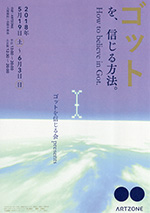 |
|
| How to believe in Got. |
| 19 May - 3 June 2018 |
Artzone
(Kyoto) |
 |
| The art unit exonemo’s “Spiritual Computing” series explored the mystical aspect of computers and cyberspace, along the way coining the name “Got” (from a Twitter search typo for “God”) for the ghost in the machine. Ten years later, the anonymous “Society of Believers in Got” reconstructs the series and attempts to prove that Got indeed exists. The present show is a challenging but praiseworthy effort to go beyond merely playing with technology to critiquing it, transforming the original work by incorporating the physical sensations induced by changes in the media environment. |
|
|
 |
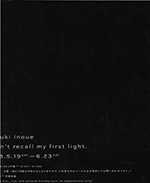 |
 |
| Sayuki Inoue: I can’t recall my first light. |
| 19 May - 23 June 2018 |
Nap Gallery
(Tokyo) |
 |
| This is a lovely and poignant long-term photo project. For two years, Inoue photographed her grandfather’s eyes as he lay in his sickbed. As the end of his life approached, his eyes gradually lost their luster. Watching this process, Inoue thought about capturing on camera the eyes of newborns when they first open. Negotiating with a maternity hospital, she gained permission to photograph babies within five minutes of their birth, producing a series of images that have something sweetly nostalgic about them. Perhaps it’s because the experience of viewing one’s first light is shared by all human beings, even if we can’t remember it. |
|
|
|
|
|
|
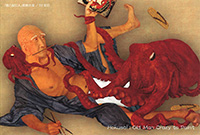 |
 |
Kimiaki Ishizuka: Pictorialism Ⅲ |
12 - 25 May 2018 |
Aoki Gallery
(Tokyo) |
 |
| Ishizuka sculpts dolls modeled after famous Japanese writers and photographs them against evocative backgrounds. Until now he has employed classical techniques like oil printing that belong to the same era as his subjects, but in this, his third solo presentation, he has attempted to portray the figures without shadowing, in ukiyo-e fashion. Some of the 27 works on display, however, contain shadowing added later as figments of the artist’s own imagination. Ishizuka’s quest continues to take him in intriguing directions. |
|
 |
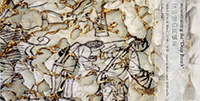 |
 |
| Yukawa-Nakayasu: Reconstructing the “Deep Breath” |
| 25 May - 10 June 2018 |
Gallery PARC
(Kyoto) |
 |
| This art unit assembles bricolage-like works from everyday items acquired at flea markets, found objects, and stones, seeds and other natural materials. The duo’s delicate creations bring to mind ritual implements, talismans and the like. Aspiring to “the construction of a history of fertility,” Yukawa and Nakayasu ask, “What is fertility or abundance?” Based on their research into folk beliefs, local customs and personal histories, they produce objects that give form to ways of thinking that have been discarded by the modern art world. |
|
|
|
|
 |
|